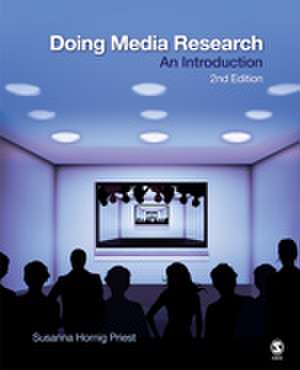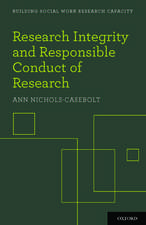Doing Media Research: An Introduction
Autor Susanna Horning Priesten Limba Engleză Paperback – 11 mai 2009
Preț: 982.08 lei
Preț vechi: 1345.31 lei
-27% Nou
Puncte Express: 1473
Preț estimativ în valută:
187.92€ • 196.73$ • 155.49£
187.92€ • 196.73$ • 155.49£
Carte tipărită la comandă
Livrare economică 05-19 aprilie
Preluare comenzi: 021 569.72.76
Specificații
ISBN-13: 9781412960977
ISBN-10: 1412960975
Pagini: 272
Dimensiuni: 187 x 232 x 15 mm
Greutate: 0.45 kg
Ediția:Second Edition
Editura: SAGE Publications
Colecția Sage Publications, Inc
Locul publicării:Thousand Oaks, United States
ISBN-10: 1412960975
Pagini: 272
Dimensiuni: 187 x 232 x 15 mm
Greutate: 0.45 kg
Ediția:Second Edition
Editura: SAGE Publications
Colecția Sage Publications, Inc
Locul publicării:Thousand Oaks, United States
Cuprins
PART I. ROOTS: SOCIAL SCIENCE FOUNDATIONS
1. A Philosophy of Social "Science"
Qualitative Versus Quantitative Methods
Deductive Versus Inductive Logic
Applied Versus Basic Research
The Limits of Social Science Research
2. Foundational Disciplines
Anthropology and the Range of Human Experience
Psychology and the Experimental Method
Sociology and the Study of Human Social Groups
3. Mass Communication as a Research Field
Origins of Mass Communication Research
Qualitative Versus Quantitative Research Revisited
Content Analysis as a Key Research Tool
Mass Communication and New Media
PART II. ASKING QUESTIONS AND COLLECTING DATA: CREATING A RESEARCH PLAN
4. Developing a Research Question, Reviewing the Literature, Exploring Data Sources, and Defining Variables
Reviewing the Academic Literature
The Nature of Academic Publishing
Defining and Refining Your Research Questions
More About the Role of Theory
Finding Resources and Data for Your Project
Defining and Measuring Variables
5. Designing Quantitative Research: Surveys, Experiments, and Quantitative Content Analysis
Survey Design Basics
Designing Basic Experiments
Content Analysis
6. Designing Qualitative Studies: Participant Observation, Interviews, Focus Groups, and Qualitative Content Analysis
Participant Observation
Interviews
Focus Groups
Qualitative Content Studies
PART III. APPROACHES TO DATA ANALYSIS: BASIC TOOLS
7. Describing a Numerical Data Set and Making Inferences
Levels of Measurement
Identifying and Summarizing Patterns
Reasoning From Sample to Population
8. Testing Hypotheses and Exploring Other Relationships
Testing Simple Hypotheses
Understanding Chi-Square
Comparing Two Means
Working With Complex Variables
Multivariate Techniques for Statistical Analysis
9. Qualitative Analysis: Identifying Themes and Writing Meaningful Summaries
Working With Theory and Identifying Themes
Analyzing Qualitative Data
Other Forms of Analysis
Writing Descriptive Summaries
Relating Data to Conclusions
PART IV. RESEARCH IN BROADER CONTEXT: CONTEMPORARY TRENDS IN THE DISSEMINATION OF RESEARCH RESULTS
10. Research Horizons: Opportunities and Challenges
New Media Technology
Research in a Global Village
Ethics in Research: A Further Note
11. Writing and Presenting the Research Report
Constructing the Research Paper
About Conference Presentations
A Concluding Note
1. A Philosophy of Social "Science"
Qualitative Versus Quantitative Methods
Deductive Versus Inductive Logic
Applied Versus Basic Research
The Limits of Social Science Research
2. Foundational Disciplines
Anthropology and the Range of Human Experience
Psychology and the Experimental Method
Sociology and the Study of Human Social Groups
3. Mass Communication as a Research Field
Origins of Mass Communication Research
Qualitative Versus Quantitative Research Revisited
Content Analysis as a Key Research Tool
Mass Communication and New Media
PART II. ASKING QUESTIONS AND COLLECTING DATA: CREATING A RESEARCH PLAN
4. Developing a Research Question, Reviewing the Literature, Exploring Data Sources, and Defining Variables
Reviewing the Academic Literature
The Nature of Academic Publishing
Defining and Refining Your Research Questions
More About the Role of Theory
Finding Resources and Data for Your Project
Defining and Measuring Variables
5. Designing Quantitative Research: Surveys, Experiments, and Quantitative Content Analysis
Survey Design Basics
Designing Basic Experiments
Content Analysis
6. Designing Qualitative Studies: Participant Observation, Interviews, Focus Groups, and Qualitative Content Analysis
Participant Observation
Interviews
Focus Groups
Qualitative Content Studies
PART III. APPROACHES TO DATA ANALYSIS: BASIC TOOLS
7. Describing a Numerical Data Set and Making Inferences
Levels of Measurement
Identifying and Summarizing Patterns
Reasoning From Sample to Population
8. Testing Hypotheses and Exploring Other Relationships
Testing Simple Hypotheses
Understanding Chi-Square
Comparing Two Means
Working With Complex Variables
Multivariate Techniques for Statistical Analysis
9. Qualitative Analysis: Identifying Themes and Writing Meaningful Summaries
Working With Theory and Identifying Themes
Analyzing Qualitative Data
Other Forms of Analysis
Writing Descriptive Summaries
Relating Data to Conclusions
PART IV. RESEARCH IN BROADER CONTEXT: CONTEMPORARY TRENDS IN THE DISSEMINATION OF RESEARCH RESULTS
10. Research Horizons: Opportunities and Challenges
New Media Technology
Research in a Global Village
Ethics in Research: A Further Note
11. Writing and Presenting the Research Report
Constructing the Research Paper
About Conference Presentations
A Concluding Note
Notă biografică
Descriere
Written in a straightforward and engaging style, this text takes the student through media research step-by-step.









